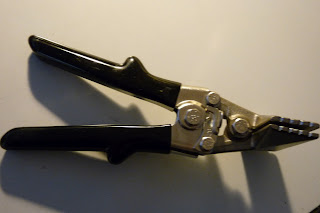Ok, so it's not about color but I wanted to help you fellow artists who stretch their own canvas. First off, both Tony and I stretch, prime and prepare all our canvas and for the last few years have been using the genius method of James Bernstein, a conservator who I believe came up with this fantastic method of stretching canvas. It takes longer but the results are great. I highly recommend it! Just google his name and it should be under a GOLDEN acrylics article.
Anyway, if you stretch you canvases you really need a sturdy pair of canvas pliers to make your work easier and most pairs out there are cheap, break easily or are solid and quite expensive. After using this pair of pliers (above) for the last few years that I paid quite a bit for, I realized after a visit to Home Depot that they are identical to a hand-seamer tool used to bend sheet metal albeit slightly modified. They have a tab that is welded onto them to use as leverage against the inside of stretcher bars so you can attach the canvas to the back - "gallery wrap". These pliers are heavy yet great but at around $100 it seems a bit steep as the tool wasn't actually designed by artists but was simply modified. It left me wondering how much that modification really costs..
I wanted a 6" pair (my current bought pair was 3") for large canvases and they can be even more expensive so I figured it should be worth trying to replicate. I did, it worked and was cost effective.. Here's what you can do. Scour ebay for hand seamers : 3" for most canvases, 6" for big canvases. If you intend to gallery wrap (attach canvas at the back) get the regular straight ones, otherwise get a pair of offset ones (for attaching the canvas to the sides). I got a 6" straight pair for $30 (see lower pic). Then take them to a local welder and have them weld a small tab (ask me if u need specs, it can be wider than shown but shouldn't be deeper than the narrowest stretcher bars you intend to use) onto one side of the jaws (on the gallery wrap types is doesn't matter which side but on the offset one it has to be the underside jaws and facing down to provide leverage). Make sure the tab is flush with the inside of the jaws. Cost me about $15. Voila! Done. So until someone comes out with the perfect pliers that isn't just an easily modified tool/ or expensive I'd rather save my money with these.
I hope this helps some folks out there. If you need more specs send us email or comment!
Monday, May 21, 2012
Friday, May 11, 2012
Questions about color?
Color is complicated, no doubt about that which is why I'm hard at work making the second book to follow up on the first one (Making Sense of Color). This next one focuses on color observation and color design. It's going to clear up some common myths which I feel are propagated in modern teaching, even in "good" art schools. Color is not tied to any type of visual art (realism, photo-realism, abstract, representational etc.) and I really hope this next book will allow people to learn color in a way that is very individual yet truthful.
In the meantime, what sorts of concerns do you have about color and why?
In the meantime, what sorts of concerns do you have about color and why?
Thursday, May 10, 2012
Black is not Black, White is not White
Here is a series of block quick-sketches (10-15min) done on a mostly cloudy day with some intermittent creeping sun, done about every hour. The point here is to observe subtle light changes throughout the day. The paintings are not overly chromatic but subtly intense and I'm not sure how well they would read online compared to the originals as they are layered and impressionistic (which is always a problem with photographical translation so I tweaked in them to look a little more correct on a computer though this makes them less subtle compared to the originals). There are some important things to note about this exercise: I did not use black paint, only a full spectrum palette; the emphasis is not on value contrast but color and not on over-emphasized color but truthful, relative color intensities. Drawing obviously took a back seat.
My goal here is to show that black is never really black and white is never really white (except if you design it that way) and that careful observation of color leads to understanding that it is not absolute color that is important but the intensity of color relationships.
I hope to show more of these types of sketches when we get some more consistently sunny days (without that veil of clouds) here so that you can see that outdoor lighting is never consistent and that registering color atmosphere doesn't always mean painting loud color.
Our next book is coming out soon and will address the myths of color design out there and give practical advice on how to learn color design without falling into these traps..I'll keep you posted!
Subscribe to:
Comments (Atom)


